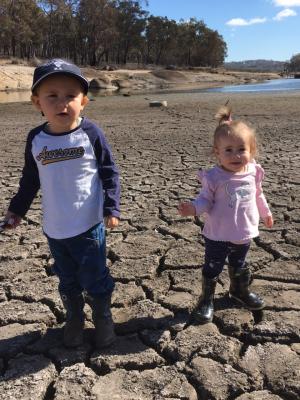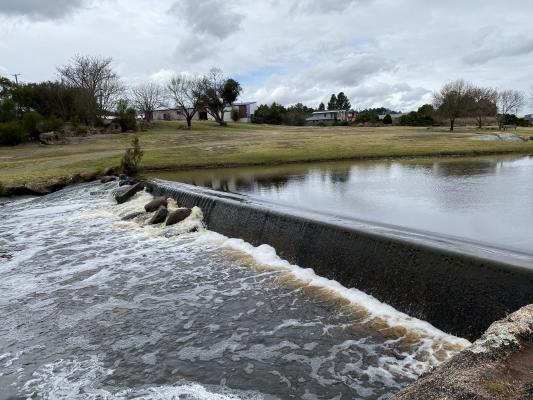By Jess Baker
This time last year, the Granite Belt was in crisis.
Stanthorpe’s water supply at Storm King Dam was dismally low at 17.5 per cent capacity and water carting was constant.
Stanthorpe and Granite Belt Chamber of Commerce Secretary Amanda Harrold said she would never forget the “despair” she witnessed at the time.
“It really almost brought the community to (its) knees,” Ms Harrold said.
One year on, Storm King Dam is 100 per cent full and has resumed its duty as the sole supply for Stanthorpe’s urban supply network.
But locals warn the Granite Belt is not out of the woods yet.
“This is what happens. We have a drought and then we have a flood,” Ms Harrold said.
Ms Harrold said it was crucial the pursuit of water security remained a priority for Southern Downs Regional Council and local residents.
“I think you do get complacent. Life goes on and you do sort of push it to the back, but you can’t do that anymore,” she said.
“Because we don’t just have to worry about the drought, we also have to worry about the fact we’ve got this population increase.
“We can’t keep piping water and increasing the population and not increasing water storage.”
A staunch supporter of the Granite Belt Irrigation Project, Ms Harrold argued building Emu Swamp Dam was “one part of the solution”, but not the entire – nor “perfect” – solution.
The project, which aims to deliver a 12,000-megalitre dam at Emu Swamp and 3900 megalitres of water to 50 customers via 126 kilometres of pipeline through the Granite Belt, is now in its pre-construction phase.
Construction of the proposed dam remains a controversial topic amongst Southern Downs Regional Council residents, which Ms Harrold said partly came down to a “misconception” of the project.
She said some had questioned why different levels of government would invest in the “irrigation dam”, as the dam would not benefit the wider community.
“That is just not true at all … there will be benefits,” Ms Harrold said.
“The farmers increase production, they have that water reliability, they employ local people, they spend in local shops, they send their kids to the schools …”
Ms Harrold said if Southern Downs Regional Council decided to invest in Emu Swamp Dam, it would “better be able to manage its water resources”.
Southern Downs Mayor Vic Pennisi said the council was still committed to becoming a customer of the Granite Belt Irrigation Project, and it was also exploring a number of other options for increased water security for the region.
“Water is front and centre,” Cr Pennisi said.
“Today we are one day closer to the next drought – and we can’t forget the drought – and we must make sure that we have done something between now and then that enables us not to be in the same position that we were (in).”
Cr Pennisi said he had long been advocating for a solution to the Southern Downs and Granite Belt’s water issues and he would continue to into the future.
“Even after we build Emu Swamp Dam and we have access to almost double what’s in Storm King Dam, that will not be a solution for 150 years,” he said.
“It will be a solution for 50 years, but not 150 years.”
He said the council was still investigating whether building a pipeline from Toowoomba to Warwick was a viable option for the region.
Led by the Queensland government, a detailed business case for the pipeline is still in the works and the potential cost to Southern Downs ratepayers is still unknown.
“The solution, in my view, is a number of things. New water is critically important and an absolute focus for us,” Cr Pennisi said.
“It’s great to have a pipeline, but what’s it going to do to Toowoomba’s water supply? If we’re using Toowoomba’s water to supply water to us, what’s happening to their water security?
“Our focus is to find new sources of water that are able to be sustained for the next 150 years.”
Cr Pennisi said water security was very much still a priority for him and the council, and he personally had not forgotten the dire impacts of the recent drought.
Only this time last year, hundreds of rural Granite Belt residents were waiting for their weekly 1000-litre water ration from local charity Granite Belt Water Relief.
Co-founder of the charity Russell Wantling said he and his many volunteers would often work half the night to provide clean water to local residents.
In its busiest week, Granite Belt Water Relief gave away 360,000 litres of water to drought-stricken families.
“It was so hard … people were coming to me and saying ‘we just can’t stay in the town any longer, we can’t bring up our children in these sorts of conditions’,” Mr Wantling said.
“And I just used to have to say: ‘hang in there, it’s going to rain. We’re one day closer to rain’.”
Mr Wantling said he was concerned the Granite Belt community would not cope if faced with the same challenges once again.
“We will go through another drought and I just hope the powers that be are doing the right things at the moment,” he said.
“We’ve got to stop mucking around, we’ve got to get water storage, and we’ve got to look at all the avenues. Every possibility, they’ve got to look at.”








